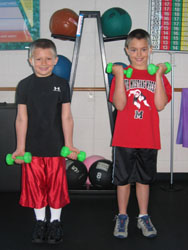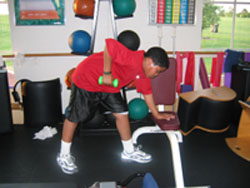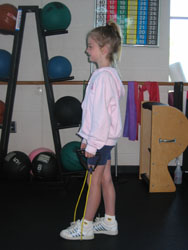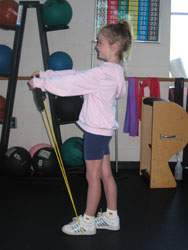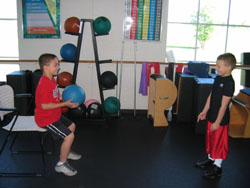About 15 percent of children and adolescents ages 6-19 years are seriously overweight.
The percentage of children and adolescents who are defined as overweight has nearly tripled since the early 1970s.
Over 10 percent of preschool children between ages 2 and 5 are overweight.
Another 15 percent of children and teens ages 6-19 are considered at risk of becoming overweight.
Researchers found that lowered self-esteem was associated with being overweight in girls as young as 5.
1 in 5 children in the U.S. are overweight.
Children with obesity, ages 10-13, are reported to have a 70% likelihood of obesity persisting into adult years.
Centers for Disease Control and Prevention's (CDC), 1999-2000 National Health and Nutrition Examination Survey (NHANES)
Resistance Training for Children 6-9 Years Old
By Debi Pillarella, M.Ed.
Children at this age can begin to use external resistance in addition to their own body weight. Light weights, bands, tubes, and light weight medicine balls are all good choices. Make sure the children can successfully complete the exercises listed below without resistance first. Then teach safe and effective prop use before allowing children to work with them.
Musical Fitness
Target Muscles: Variety
Music: Kid’s Choice (as long as the lyrics are appropriate)
Props: Chairs (one for each child), Light Dumbbells, Long Bands with Handles, Lightweight Medicine Balls
Game Instructions: Prior to playing this game, teach the following exercises:
Bicep Curls with Light Dumbbells – In a standing position, with arms extended at each side, one weight in each hand, and elbows at the waist line, contract the biceps then bend the elbows so the weights move toward the shoulders. (See photo below.)
Hold for two seconds and then slowly return the dumbbells to their starting position. Remember to exhale on the flexion (when bending elbows) phase and inhale on the extension (straightening the elbows) phase.
Tricep Extensions with Light Dumbbells – In a standing position with one hand placed on the seat of the chair while facing the chair, the other hand holding a light dumbbell extended at the side and hips and shoulders facing the floor, begin by bending the elbow so it is pointing toward the ceiling. (See photos below.)
Contract the triceps so the elbow extends and the dumbbell moves toward the rear. (See photo below.)
Hold for two seconds and then slowly return the dumbbell to its starting position. Remember to exhale on the flexion (when bending elbows) phase and inhale on the extension (straightening the elbows) phase.
Front Shoulder Raises with Long Bands – Step on the band so feet are shoulder width apart (a more narrow stance as well as standing with one foot on the band will decrease the difficulty of the exercise). Use each hand to hold the handles with a firm grip. Begin by placing the hands in front of the body, resting on the front of the thighs. (See photo below.)
While keeping wrists straight, contract the front shoulder muscles so the arms move forward and upward. (See photo below.)
Hold for two seconds and then slowly return the band to its starting position. Remember to exhale as the hands are moving upward and inhale as hands are returning to starting position.
Toss and Squat – Using a lightweight medicine ball, complete squats (use a chair seat as a guide to assure children’s hips are behind the knee region) while tossing the ball into the air during the standing phase and catching the ball during the squatting phase. (See photos below.)
Game directions: Have enough chairs so each child gets one. Place a prop atop each chair seat (e.g., weights, medicine ball, etc.). Place an exercise title card on the chair so it is visible (e.g., Bicep Curl, Tricep Extension, etc.). Review all exercises so children will know what to do when they get to that chair. Direct the children to move around the outside of the chairs (e.g., walking, running, hopping, etc.) while the music is playing. When the music stops, they must find a chair and complete that exercise until the music begins playing again (e.g., 15 seconds, 30 seconds, etc.).
Resistance Training for Children 10-12 Years Old
By Debi Pillarella, M.Ed.
Children at this age enjoy setting and achieving goals. They don’t think themes are cool, so you have to be creative when setting up their exercise programs. They also are not miniature adults, so taking adult exercise programs and using them with children just won’t work. Here’s a creative, fun game that can work all the major muscles of the body.
Rolling Dice Fitness
Target Muscles: Variety
Props Needed: Dice, light dumbbells, bands, tubes, and lightweight medicine balls are all good choices. Make sure the children can successfully complete the exercises listed below without resistance first. Then teach safe and effective “prop” use before allowing children to work with them.
Game Set Up: Pre-design a wall chart with six exercises that correspond to the numbers 1-6 (e.g., 1=Curl-ups, 2=Push-ups, 3=Bicep Curls with Light Dumbbells, etc.). Teach the exercises to the children before playing the game.
Game directions: Partner the children and give them a dice. Have them take turns rolling the dice. The number they roll corresponds to an exercise on the “wall chart”. They should complete a designated number (you designate repetition quantity or have children set their own class/personal goals) of repetitions of that exercise (e.g., 12 repetitions of #1 Exercise: Curl-up). One of the partners will be responsible for counting the reps, the other responsible for rolling the dice. Have them take turns so they each get a chance to do each duty.
